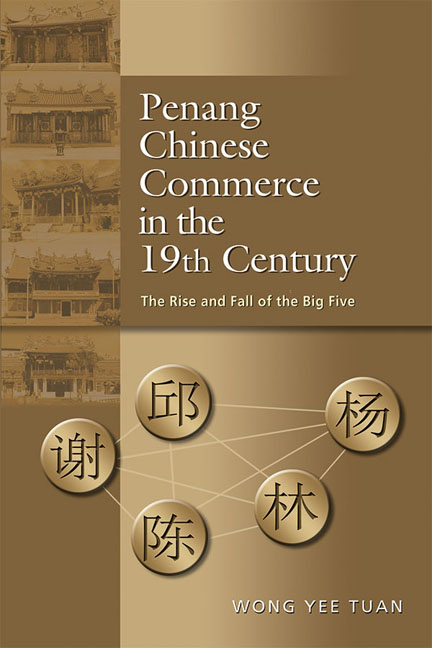Book contents
- Frontmatter
- Dedication
- Contents
- List of Tables, Diagrams and Maps
- Acknowledgements
- Glossary
- Abbreviations and Acronyms
- Notes on Spelling and Names
- Notes on Currencies
- Map
- 1 Introduction
- 2 Penang and the Big Five in Regional Context
- 3 Kith and Kin: The Big Five Familial Web
- 4 Opium Farm Rivalry
- 5 The Contest for ‘White Gold’
- 6 Western Mercantile Elite and Their Challenge to the Penang Chinese
- 7 New Regional Order and the Decline of the Big Five
- 8 Conclusion
- Appendices
- Bibliography
- Index
- About the Author
- Platesection
- Map
3 - Kith and Kin: The Big Five Familial Web
Published online by Cambridge University Press: 19 May 2017
- Frontmatter
- Dedication
- Contents
- List of Tables, Diagrams and Maps
- Acknowledgements
- Glossary
- Abbreviations and Acronyms
- Notes on Spelling and Names
- Notes on Currencies
- Map
- 1 Introduction
- 2 Penang and the Big Five in Regional Context
- 3 Kith and Kin: The Big Five Familial Web
- 4 Opium Farm Rivalry
- 5 The Contest for ‘White Gold’
- 6 Western Mercantile Elite and Their Challenge to the Penang Chinese
- 7 New Regional Order and the Decline of the Big Five
- 8 Conclusion
- Appendices
- Bibliography
- Index
- About the Author
- Platesection
- Map
Summary
The secret of how the Big Five could assert their dominance in the Penang region lies in the multiple alliances between them and other prominent families. However, different from the conventional beliefs that Chinese family networks were as closed as they could be, cross-dialect and crossethnic alliances played a major role in the Big Five's business partnerships. Yet this cluster of five families was able to form all these alliances and attain their economic predominance in the face of the fluid and plural socio-economic environment of the region. This chapter explores how and why this situation came about.
The family network of the Big Five, which was composed of a web of kinship ties based on extended consanguineal lineages and strategic intermarriages, inextricably bound the five families together and while also connecting them to other prominent Hokkien and Hakka families. Further a field, Indo-Malay families in Penang, Kedah, Perak and North Sumatra as well as Siamese and Chinese families in southern Siam and southern Burma were all woven into the net of marriage alliance. Extensive criss-crossing of kinship ties clearly served as an important foundation for the forging of inter-family and inter-ethnic alliances and partnerships between business families in the promising, yet potentially hostile and insecure, environment of competing colonial and indigenous powers. Through this web of kinship ties the Big Five families were able to establish their business concerns in Penang and the surrounding states.
Clan association in Penang is more popularly known as kongsiand here it refers to an autonomous organization of shared interests based upon blood ties and geographical affinity among its members. Each of the Big Five was grouped within and represented by its own kongsi: the Seh Khoo Kongsi, the Seh Cheah Kongsi, the Seh Yeoh Kongsi, the Seh Lim Kongsi, and the Seh Tan Kongsi (Yen 1995, pp. 81–86). Both Cheah Kongsi and Tan Kongsi were established in 1810; it was then followed by the Yeoh in 1834, the Khoo in 1835, the Tan in 1851, and the Lim in 1863. With such groupings each of the five families was able to develop extended consanguineal lineages which in turn led to the formation of a substantial agnatic or blood-related kinship group.
- Type
- Chapter
- Information
- Penang Chinese Commerce in the 19th CenturyThe Rise and Fall of the Big Five, pp. 47 - 61Publisher: ISEAS–Yusof Ishak InstitutePrint publication year: 2015



